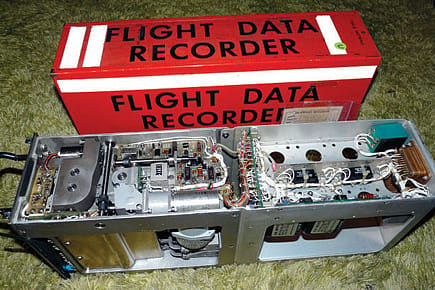Black Box

A company has developed a system that relies on the Iridium satellite network to send data in real time.
There are two recorders in every plane. The cockpit voice recorder captures cockpit conversations and radio communications. The flight data recorder, commonly known as the black box, collects data on parameters such as the thrust of each engine, altitude, air speed and vertical acceleration. Under US federal regulations, it is mandatory for at least 88 vital parameters to be recorded. Under the newer standard being adopted, plane makers such as Boeing have opted for the Enhanced Airborne Flight Recorder, which combines the functions of the data recorder, cockpit voice recorder, image recorder and data link recorder, and can record thousands of parameters.
The recorders are often encased in a thick titanium or stainless steel shell painted in heat-resistant bright red or orange, and placed at the tail end of planes. Before it gets to a plane, the protected memory unit of the recorders goes through a series of tests that replicate conditions tougher than those of real crashes. They undergo fire tests (it is baked at 1,100° centigrade for an hour), impact tests (3,400 times the force of gravity, although one, the Fairchild cockpit voice recorder, is said to have survived 6,000 Gs), deep-sea and salt-water submersion tests, a pin-drop test involving a steel pin attached to the end of a 227 kg weight dropped from a height of ten feet. But while the coverings make the recorders hard to destroy, they can be damaged badly and, in some instances, difficult to locate.
2026 New Year Issue
Essays by Shashi Tharoor, Sumana Roy, Ram Madhav, Swapan Dasgupta, Carlo Pizzati, Manjari Chaturvedi, TCA Raghavan, Vinita Dawra Nangia, Rami Niranjan Desai, Shylashri Shankar, Roderick Matthews, Suvir Saran
People argue for a more evolved kind of black box precisely because in its present state, it needs to be found for data to be analysed. When the Air France black box stopped 'pinging' its location on 30 June, the argument for live air-to-ground data transmission grew stronger. One company that has developed a system that relies on the Iridium satellite network to send batches of data in real time says it now has 30 customers.
Sources: Federal Aviation Administration, Boeing, Howstuffworks.com, Avionics Magazine, Air Transport Association of America, Flightglobal.com.
